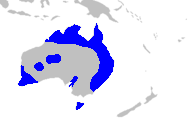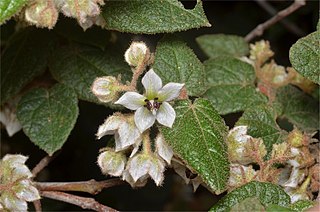
Xanthorrhoea is a genus of about 30 species of flowering plants endemic to Australia. Species are known by the name grass tree.

Waratah (Telopea) is an Australian-endemic genus of five species of large shrubs or small trees, native to the southeastern parts of Australia. The best-known species in this genus is Telopea speciosissima, which has bright red flowers and is the NSW state emblem. The Waratah is a member of the family Proteaceae, flowering plants distributed in the Southern Hemisphere. The key diagnostic feature of Proteaceae is the inflorescence, which is often very large, brightly coloured and showy, consisting of many small flowers densely packed into a compact head or spike. Species of waratah boast such inflorescences ranging from 6–15 cm in diameter with a basal ring of coloured bracts. The leaves are spirally arranged, 10–20 cm long and 2–3 cm broad with entire or serrated margins. The name waratah comes from the Eora Aboriginal people, the pre-European inhabitants of the Sydney area.

Telopea speciosissima, commonly known as the New South Wales waratah or simply waratah, is a large shrub in the plant family Proteaceae. It is endemic to New South Wales in Australia and is the floral emblem of that state. No subspecies are recognised, but the closely related Telopea aspera was only recently classified as a separate species.

Eremophila is a genus of more than 260 species of plants in the figwort family, Scrophulariaceae all of which are endemic to mainland Australia.. Eremophilas are widespread in the arid areas of Australia, especially Western Australia and range in size from low-growing shrubs to small trees. The petals are joined, at least at their bases, into a tube with the upper petals different in size and shape from the lower ones. Some species have common names including emu bush, poverty bush or fuchsia bush, reflecting the belief that emus eat the fruit, their arid environment or a superficial resemblance to the flowers of plants in the genus Fuchsia.

Protea aristata is a compact shrub with beautiful flowers which is endemic to the southwestern part of the Cape Region of South Africa. P. aristata has become one of South Africa's most famous proteas in spite of its relatively late discovery, and re-discovery in 1953. The leaves are soft, dense and needle-like and the flower heads are a stunning crimson red, it may thus be a good potential ornamental plant for South African gardens. It is usually called the Ladismith sugarbush in South African English, although it has been called pine sugar bush in Australia. In the Afrikaans language it has the vernacular name of klein-den-suikerbos.

Myoporum insulare, commonly known as common boobialla, native juniper, is a species of flowering plant in the figwort family Scrophulariaceae and is endemic to coastal areas of Australia. It is a shrub or small tree which grows on dunes and coastal cliffs, is very salt tolerant and widely used in horticulture.

Homoranthus wilhelmii, commonly known as the eastern feather flower, is a species of flowering plant in the family Myrtaceae and is endemic to South Australia. It is a small, spreading shrub with cylindrical to flattened leaves and white or pink flowers arranged in corymbs on the ends of branchlets. The distribution includes an area on the Yorke Peninsula, but it is most common on the southern Eyre Peninsula.

Lasiopetalum behrii, commonly known as the pink velvet bush, is a species of flowering plant in the family Malvaceae and is endemic to southern continental Australia. It is an erect shrub with lance-shaped, narrowly oblong to narrowly elliptic leaves and groups of white to pink and reddish-brown flowers.

Franklandia is a genus of small shrubs in family Proteaceae, commonly known as lanolin bushes. It is endemic to Southwest Australia.

Hakea trifurcata, commonly known as two-leaf, two-leaved hakea, or kerosene bush, is a shrub, endemic to the south-west of Western Australia. The species has two leaf forms, needle-like or oblong egg-shaped. Unlike most hakea species the fruit remain green at maturity and resemble the broader leaf form. The mimicry creates a camouflage, reducing predation of the seed by granivores in particular cockatoos.

Hakea undulata, commonly known as wavy-leaved hakea, is a flowering plant in the family Proteaceae and is endemic to the south-west of Western Australia. It has stiff wavy leaves and fragrant cream-white flowers from mid-winter to October.

Lasiopetalum schulzenii, commonly known as drooping velvet-bush, is a species of flowering plant in the family Malvaceae and is endemic to southern continental Australia. It is a shrub with heart-shaped leaves and small groups of hairy white and reddish-brown flowers.
Philotheca pungens, commonly known as prickly waxflower, is a species of flowering plant in the family Rutaceae and is endemic to south-eastern Australia. It is an undershrub with linear to narrow oblong or needle-like leaves and white flowers usually arranged singly in leaf axils.

Grevillea christineae, commonly known as Christine's grevillea, is a species of flowering plant in the family Proteaceae and is endemic to the south-west of Western Australia. It is an erect, rounded shrub with wiry branches, linear to narrowly elliptic leaves, and white flowers.

Stenocarpus cunninghamii, commonly known as little wheel bush, is a species of flowering plant in the family Proteaceae and is endemic to northern Australia. It is a shrub or small tree with simple, narrow elliptic or lance-shaped adult leaves, groups of pale yellow or white flowers and woody, linear follicles.

Grevillea dimidiata, also known as the caustic bush or willings tree, is a species of flowering plant in the family Proteaceae and is endemic to northern Australia. It is a shrub or small tree with glabrous, more or less sickle-shaped, curved leaves with wavy edges, and cylindrical groups of greenish-white to cream-coloured flowers.
Petrophile nivea is a species of flowering plant in the family Proteaceae and is endemic to southwestern Western Australia. It is a small shrub with crowded cylindrical, sharply-pointed leaves and more or less spherical heads of hairy white or cream-coloured flowers on the ends of branchlets.
Petrophile vana is a species of flowering plant in the family Proteaceae and is endemic to Western Australia. It is a shrub with needle-shaped, sharply-pointed leaves, and spherical to oval heads of small numbers of hairy, white flowers.

Protea scabriuscula, also known as the hoary sugarbush or gray sugarbush, is a flowering shrub, endemic to the southwestern Cape Region of South Africa.

Franklandia fucifolia, or lanoline bush, is native to the south-west of Western Australia. It is a species in the Franklandia genus of the Proteaceae family.














